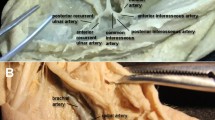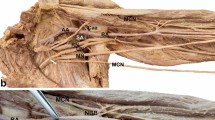Summary
Persistent median artery was studied in 60 upper limbs of 30 neonatal cadavers. It was found in 12 (20%) specimens while partial atrophy in the distal part of the median artery was detected in 9 (15%) specimens. These findings correlated well with those of other series including the authors' previous study which covered both adults and neonates. There was no significant difference statistically between the authors' current and previous studies (p>0,05). Therefore both studies were combined. The incidence of persistent median artery in this enlarged series (100 specimens) was 17%. This rate of persistent median artery was higher than those of most other published series. We believe this may be due to evolutionary and racial trends; the neonatal origin of our specimens would be another differing factor. Partial atrophy of the median artery, and the different incidences in neonates and adults raised the possibility that the median artery regresses at a later age, possibly during perinatal and early infancy period.
Résumé
La persistance de l'a. médiane a été recherchée sur 60 membres supérieurs provenant de 30 cadavres de nouveau-nés. Elle a été trouvée sur 12 pièces (20 % des cas) tandis qu'une atrophie localisée de la partie distale de l'a. médiane était détectée sur 9 pièces (15 %). Ces constatations ont une bonne corrélation avec celles d'autres séries, y compris l'étude antérieure des auteurs portant à la fois sur des adultes et des nouveau-nés. Il n'y avait pas de différence statistiquement significative entre l'étude rapportée ici et la précédente (p>0,05). C'est pourquoi les deux études ont été rassemblées. La fréquence de la persistance d'une a. médiane dans cette étude élargie (100 cas) a été de 17 %. Ce taux d'a. médiane persistante est plus élevé que celui de la plupart des autres séries publiées. Nous pensons qu'il peut être lié à des facteurs évolutifs et ethniques ; l'origine néonatale de nos observations a pu être un autre facteur différentiel. L'atrophie partielle de l'a. médiane et la différence de fréquence chez le nouveau-né par rapport à l'adulte proviennent de la possibilité qu'a l'a. médiane de régresser à un stade plus tardif, peut-être durant la période périnatale ou dans la première enfance.
Similar content being viewed by others
References
Adachi B (1928) Das Arteriensystem der Japaner. Kyoto, 1
Aulicino PL, Klavans SM, DuPuy TE (1984) Digital ischemia secondary to thrombosis of a persistent median artery. J Hand Surg 9-A: 820–823
Barfred T, Hojlund AP, Bertheussen K (1985) Median artery in carpal tunnel syndrome. J Hand Surg 10-A: 864–867
Basmajian JV, Slonecker CE (1989) Grant's method of anatomy: A clinical problem-Solving Approach, 11th edn. Williams & Wilkins, Baltimore, pp 402–404
Braun JB (1977) Arteries of the hand. Thesis, Nancy, France
Cocchetti E, Bondam L (1954) Osservazioni anatomo-radiografiche sulle arterie dell'arto superiore durante la vita fetale. Ateneo Parmense 25: 1
Coleman SS, Anson BJ (1961) Arterial patterns in the hand based on a study of 650 specimens. Surg Gynecol Obstet 113: 409
Dickinson JC, Kleinert JM, Kentucky L (1991) Acute carpal tunnel syndrome caused by a calcified median artery. J Bone Joint Surg [Am] 73-A: 610–611
Fullerton PM (1963) The effect of ischemia on nerve conduction in the carpal tunnel syndrome. J Neurol Neurosurg Psychiatry 26: 385
Faithfull DK, Wallace RF (1987) Traumatic rupture of median artery. An unusual cause for acute median nerve compression. J Hand Surg 12-B: 223–235
Grant JCB (1962) An atlas of anatomy. Williams & Wilkins, Baltimore, p 60
Hollinshead WH (1969) Anatomy for surgeons, Vol 3. Harper-Row, New York, pp 210–211
Henneberg M, George BJ (1992) High incidence of the median artery of the forearm in a sample of recent Southern African cadavers. J Anat 180: 185–188 B
Henneberg M, George BJ (1992) A further study of the high incidence of the median artery of the forearm in Southern Africa. J Anat 181: 151–154 A
Julliard A (1971) Indications chirurgicales et étiologies dans les syndromes du canal carpien. Ann Chir Plast 16: 288
Janevski B (1982) Angiography of the upper extremity. Thesis, Leiden, The Hague, Boston, London
Kulbertus H, Baudinet V, Collignon P (1966) Phénomènes de Raynaud et syndrôme du canal carpien. Rev Med Liège 21: 319
Kenesi C, Alexandre JH, Aaron C (1967) Arterial blood supply of the hand. Arch Anat Path 15: 99–102
Kopuz C, Gülman B, Baris S (1995) Persistent median artery: An anatomical study in neonatal and adult cadavers. Acta Anat Nippon 70: 577–580
Kopuz C, Fidan B, Islam A (1997) An unusually distal and complete additional flexor profundus muscle to the index finger. J Anat 191: 00
Lacoste P, Dalle M (1966) Anomalie artérielle de l'avant-bras et de la main. Essai d'interprétation embryologique. CR Assoc Anat 132: 563–570
Luyendijk W (1986) The carpal tunnel syndrome: The role of a persistent median artery. Neurochirurgica 79: 52–57
McCormack LJ, Cauldwell EW, Anson BJ (1953) Brachial and antebrachial arterial patterns. Surg Gynecol Obstet 96: 43–54
Misra BD (1955) The arteria mediana. J Anat Soc India 4: 48
Mauppin JMC (1980) Arteries of the palm: A study of 100 anatomical preparations. Thesis, Lille, France, pp 1–142
Pecket P, Gloobe H, Nathan H (1973) Variations in the arteries of the median nerve. Clin Orthop 97: 144–147
Singer E (1933) Embryological pattern persisting in the arteries of the arms. Anat Record 55: 403
Srivastava SK, Pande BS (1990) Anomalous pattern of median artery in the forearm of Indians. Acta Anat 138: 193–194
Sanudo JR, Chikwe J, Evans SE (1994) Anomalous median nerve associated with persistent median artery. J Anat 185: 447–451
Testut L (1902) Tratado de anatomia humana, 6th edn. Tomo segundo. Salvat y Ca S. en C., Barcelona, p 226
Toranto IR (1989) Aneurysm of the median artery causing recurrent carpal tunnel syndrome and anatomic review. Plast Reconstr Surg 84: 510–512
Williams P (1995) Gray's Anatomy, 38th edn. Churchill & Livingstone, Baltimore, pp 1542–1544
Author information
Authors and Affiliations
Rights and permissions
About this article
Cite this article
Kopuz, C., Baris, S. & Gulman, B. A further morphological study of the persistent median artery in neonatal cadavers. Surg Radiol Anat 19, 403–406 (1997). https://doi.org/10.1007/BF01628509
Received:
Accepted:
Issue Date:
DOI: https://doi.org/10.1007/BF01628509




